Effect of Recycled Aggregate Modification on the Properties of Permeable Asphalt Concrete
Abstract
:1. Introduction
2. Experiment
2.1. Raw Material
2.2. Modification Method of RCA
2.2.1. Glacial Acetic Acid and/or Sodium Silicate Solution-Modified RCA
2.2.2. Polyvinyl Alcohol and/or Cement Slurry-Modified RCA
2.2.3. Slag Powder and/or Silane Coupling Agent-Modified RCA
2.3. Test of Aggregate Properties
2.4. Performance Test of Asphalt Concrete
2.4.1. Asphalt Mixture Gradation
2.4.2. Adhesion Test of Asphalt and Aggregate
2.4.3. Optimum Asphalt-Aggregate Ratio
2.4.4. Water Permeability Test
2.4.5. Water Stability Property
2.4.6. Freeze-Thaw Splitting Test
2.4.7. High Temperature Rutting Test
2.4.8. Low-Temperature Crack-Resistance Experiment
3. Results and Discussions
3.1. Properties of Aggregate
3.1.1. Apparent Density
3.1.2. Water Absorption
3.1.3. Crushing Value
3.2. Adhesion Performance between Aggregate and Asphalt
3.3. Optimum Asphalt-Aggregate Ratio
3.4. Permeability Performance
3.5. Water Stability Property
3.5.1. Marshall Stability
3.5.2. Marshall Stability of Immersion
3.5.3. Residual Stability
3.6. Freeze-Thaw Splitting Tensile Strength
3.7. Dynamic Stability of High Temperature Rutting
3.8. Low-Temperature Splitting Tensile Strength
4. Conclusions
Author Contributions
Funding
Conflicts of Interest
References
- Tang, Z.; Li, W.; Tam, V.W.Y.; Xue, C. Advanced progress in recycling municipal and construction solid wastes for manufacturing sustainable construction materials. Resour. Conserv. Recycl. X 2020, 6, 100036. [Google Scholar] [CrossRef]
- Tavakoli, G.M.; Mehrjardi, A.; Azizi, A.; Haji-Azizi, G.; Asdollafardi. Evaluating and improving the construction and demolition waste technical properties to use in road construction. Transp. Geotech. 2020, 23, 100349. [Google Scholar] [CrossRef]
- Arulrajah, A.; Ali, M.M.Y.; Piratheepan, J.; Bo, M.W. Geotechnical Properties of Waste Excavation Rock in Pavement Subbase Applications. J. Mater. Civil. Eng. 2012, 24, 924–993. [Google Scholar] [CrossRef]
- Tang, Z.; Hu, Y.; Tam, V.W.Y.; Li, W. Uniaxial compressive behaviors of fly ash/slag-based geopolymeric concrete with recycled aggregates. Cem. Concr. Compos. 2019, 104, 103375. [Google Scholar] [CrossRef]
- Mulder, E.; Jong, T.P.R.; Feenstra, L. Closed Cycle Construction: An integrated process for the separation and reuse of C&D waste. Waste Manag. 2007, 27, 1408–1415. [Google Scholar]
- Nwakaire, C.M.; Yap, S.P.; Onn, C.C.; Yuen, C.W.; Ibrahim, H.A. Utilisation of recycled concrete aggregates for sustainable highway pavement applications: A review. Constr. Build. Mater. 2020, 235, 117444. [Google Scholar]
- Vegas, I.; Ibañez, J.A.; San José, J.T.; Urzelai, A. Construction demolition wastes, Waelz slag and MSWI bottom ash: A comparative technical analysis as material for road construction. Waste Manag. 2008, 28, 565–574. [Google Scholar] [CrossRef]
- Nwakaire, C.M.; Yap, S.P.; Yuen, C.W.; Onn, C.C.; Koting, S.; Babalghaith, A.M. Laboratory study on recycled concrete aggregate based asphalt mixtures for sustainable flexible pavement surfacing. J. Clean. Prod. 2020, 262, 121462. [Google Scholar] [CrossRef]
- Tahmoorian, F.; Samali, B. Laboratory investigations on the utilization of RCA in asphalt mixtures. Int. J. Pavement Res. Technol. 2018, 11, 627–638. [Google Scholar] [CrossRef]
- Radević, A.; Đureković, A.; Zakić, D.; Mladenović, G. Effects of recycled concrete aggregate on stiffness and rutting resistance of asphalt concrete. Constr. Build. Mater. 2017, 136, 386–393. [Google Scholar] [CrossRef]
- Mikhailenko, P.; Rafiq Kakar, M.; Piao, Z.; Bueno, M.; Poulikakos, L. Incorporation of recycled concrete aggregate (RCA) fractions in semi-dense asphalt (SDA) pavements: Volumetrics, durability and mechanical properties. Constr. Build. Mater. 2020, 264, 120166. [Google Scholar] [CrossRef]
- Sanchez-Cotte, E.H.; Fuentes, L.; Martinez-Arguelles, G.; Rondón Quintana, H.A.; Walubita, L.F.; Cantero-Durango, J.M. Influence of recycled concrete aggregates from different sources in hot mix asphalt design. Constr. Build. Mater. 2020, 259, 120427. [Google Scholar] [CrossRef]
- Evangelista, L.; de Brito, J. Mechanical behaviour of concrete made with fine recycled concrete aggregates. Cem. Concr. Compos. 2007, 29, 397–401. [Google Scholar] [CrossRef]
- Kim, Y.; Hanif, A.; Kazmi, S.M.S.; Munir, M.J.; Park, C. Properties enhancement of recycled aggregate concrete through pretreatment of coarse aggregates—Comparative assessment of assorted techniques. J. Clean. Prod. 2018, 191, 339–349. [Google Scholar] [CrossRef]
- Lei, B.; Li, W.; Luo, Z.; Tam, V.W.; Dong, W.; Wang, K. Performance Enhancement of Permeable Asphalt Mixtures with Recycled Aggregate for Concrete Pavement Application. Front. Mater. 2020, 7, 253. [Google Scholar] [CrossRef]
- Albayati, A.; Wang, Y.; Wang, Y.; Haynes, J. A sustainable pavement concrete using warm mix asphalt and hydrated lime treated recycled concrete aggregates. Sustain. Mater. Technol. 2018, 18, e81. [Google Scholar] [CrossRef]
- Juan, M.S.; Gutiérrez, P.A. Study on the influence of attached mortar content on the properties of recycled concrete aggregate. Constr. Build. Mater. 2008, 23, 872–877. [Google Scholar] [CrossRef]
- Tang, Q.; Xiao, P.; Kou, C.; Lou, K.; Kang, A.; Wu, Z. Physical, chemical and interfacial properties of modified recycled concrete aggregates for asphalt mixtures: A review. Constr. Build. Mater. 2021, 312, 125357. [Google Scholar] [CrossRef]
- Zhang, H.; Zhao, Y.; Tao, M.; Shah, S. Surface Treatment on Recycled Coarse Aggregates with Nanomaterials. J. Mater. Civil. Eng. 2015, 28, 4015094. [Google Scholar] [CrossRef]
- Spaeth, V.; Tegguer, A.D. Improvement of recycled concrete aggregate properties by polymer treatments. Int. J. Sustain. Built Environ. 2013, 2, 143–152. [Google Scholar] [CrossRef]
- Wang, L.; Wang, J.; Qian, X.; Chen, P.; Xu, Y.; Guo, J. An environmentally friendly method to improve the quality of recycled concrete aggregates. Constr. Build. Mater. 2017, 144, 432–441. [Google Scholar] [CrossRef]
- Ali, Babar Effect of aqueous sodium silicate on properties of recycled aggregate mortar. SN Appl. Sci. 2019, 1, 1296. [CrossRef]
- Kou, S.; Poon, C. Properties of concrete prepared with PVA-impregnated recycled concrete aggregates. Cem. Concr. Compos. 2010, 32, 649–654. [Google Scholar] [CrossRef]
- Çakır, Ö. Experimental analysis of properties of recycled coarse aggregate (RCA) concrete with mineral additives. Constr. Build. Mater. 2014, 68, 17–25. [Google Scholar] [CrossRef]
- Xuan, D.; Zhan, B.; Poon, C.S. 21—Cement treatment of recycled concrete aggregates and incinerator bottom ash as road bases in pavements. In Waste and Byproducts in Cement-Based Materials; de Brito, J., Thomas, C., Medina, C., Agrela, F., Eds.; Woodhead Publishing: Sawston, UK, 2021; pp. 617–634. [Google Scholar]
- Santos, W.F.; Quattrone, M.; John, V.M.; Angulo, S.C. Roughness, wettability and water absorption of water repellent treated recycled aggregates. Constr. Build. Mater. 2017, 146, 502–513. [Google Scholar] [CrossRef]
- Ministry of Transport of China. Standard Test Methods of Bitumen and Bituminous Mixture for Highway Engineering (JTG E20-2011); China Communications Press: Beijing, China, 2011. (In Chinese)
- Ministry of Transport of China. Test Methods of Aggregate for Highway Engineering (JTG E42-2005); China Communications Press: Beijing, China, 2005. (In Chinese)
- Ministry of Housing and Urban-Rural Development Transport of China. Technical Specification for Permeable Asphalt Pavement (CJJ/T 190-2012); China Architecture & Building Press: Beijing, China, 2012. (In Chinese)
- Guo, R.; Nian, T.; Zhou, F. Analysis of factors that influence anti-rutting performance of asphalt pavement. Constr. Build. Mater. 2020, 254, 119237. [Google Scholar] [CrossRef]
- Pan, R.; Li, Y. Effect of warm mix rubber modified asphalt mixture as stress absorbing layer on anti-crack performance in cold region. Constr. Build. Mater. 2020, 251, 118985. [Google Scholar] [CrossRef]
- Hu, Y.; Tang, Z.; Li, W.; Li, Y.; Tam, V.W.Y. Physical-mechanical properties of fly ash/GGBFS geopolymer composites with recycled aggregates. Constr. Build. Mater. 2019, 226, 139–151. [Google Scholar] [CrossRef]
- Xiao, J.; Li, W.; Poon, C. Recent studies on mechanical properties of recycled aggregate concrete in China—A review. Sci. China Technol. Sci. 2012, 55, 1463–1480. [Google Scholar] [CrossRef]
- Zhu, Y.; Kou, S.; Poon, C.; Dai, J.; Li, Q. Influence of silane-based water repellent on the durability properties of recycled aggregate concrete. Cem. Concr. Compos. 2013, 35, 32–38. [Google Scholar] [CrossRef]
- Peng, C.; Chen, P.; You, Z.; Lv, S.; Zhang, R.; Xu, F.; Zhang, H.; Chen, H. Effect of silane coupling agent on improving the adhesive properties between asphalt binder and aggregates. Constr. Build. Mater. 2018, 169, 591–600. [Google Scholar] [CrossRef]
- Guo, F.; Pei, J.; Zhang, J.; Xue, B.; Sun, G.; Li, R. Study on the adhesion property between asphalt binder and aggregate: A state-of-the-art review. Constr. Build. Mater. 2020, 256, 119474. [Google Scholar] [CrossRef]
- Güneyisi, E.; Gesoğlu, M.; Algın, Z.; Yazıcı, H. Effect of surface treatment methods on the properties of self-compacting concrete with recycled aggregates. Constr. Build. Mater. 2014, 64, 172–183. [Google Scholar] [CrossRef]
- Yang, L.; QIAN, Y.; Fang, Q.; Han, Y. Effects of Recycled Coarse Aggregate Reinforcing Treated by Water-Glass on the Performance of Recycled Concrete. In Proceedings of the 3rd International Conference on Material Engineering and Application (ICMEA 2016), Shanghai, China, 12–13 November 2016. [Google Scholar]
- Ho, H.; Huang, R.; Lin, W.; Cheng, A. Pore-structures and durability of concrete containing pre-coated fine recycled mixed aggregates using pozzolan and polyvinyl alcohol materials. Constr. Build. Mater. 2018, 160, 278–292. [Google Scholar] [CrossRef]
- Etxeberria, M.; Vázquez, E.; Marí, A.; Barra, M. Influence of amount of recycled coarse aggregates and production process on properties of recycled aggregate concrete. Cem. Concr. Res. 2007, 37, 735–742. [Google Scholar] [CrossRef]
- Padmini, A.K.; Ramamurthy, K.; Mathews, M.S. Influence of parent concrete on the properties of recycled aggregate concrete. Constr. Build. Mater. 2009, 23, 829–836. [Google Scholar] [CrossRef]
- Li, G.; Xie, H.; Xiong, G. Transition zone studies of new-to-old concrete with different binders. Cem. Concr. Compos. 2001, 23, 381–387. [Google Scholar] [CrossRef]
- Yang, B.; Li, H.; Zhang, H.; Xie, N.; Zhou, H. Laboratorial investigation on effects of microscopic void characteristics on properties of porous asphalt mixture. Constr. Build. Mater. 2019, 213, 434–446. [Google Scholar] [CrossRef]
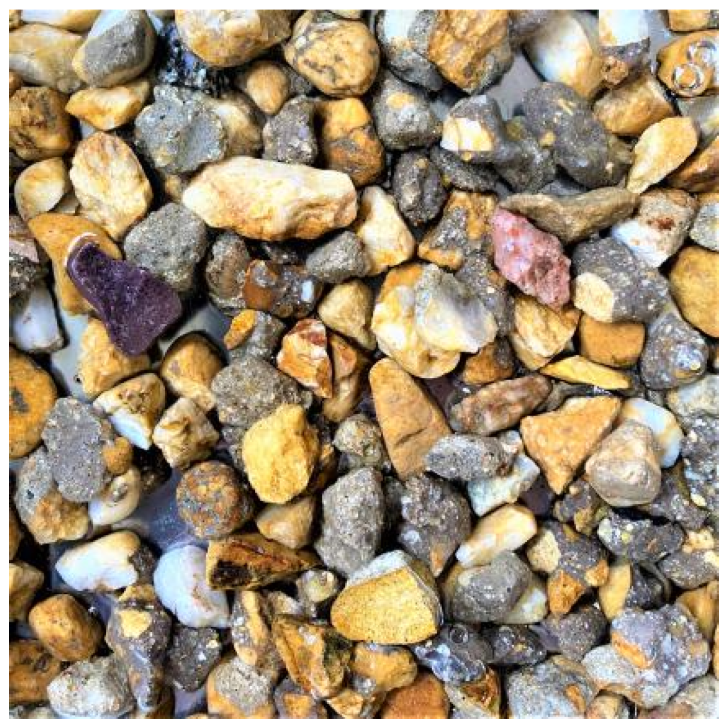
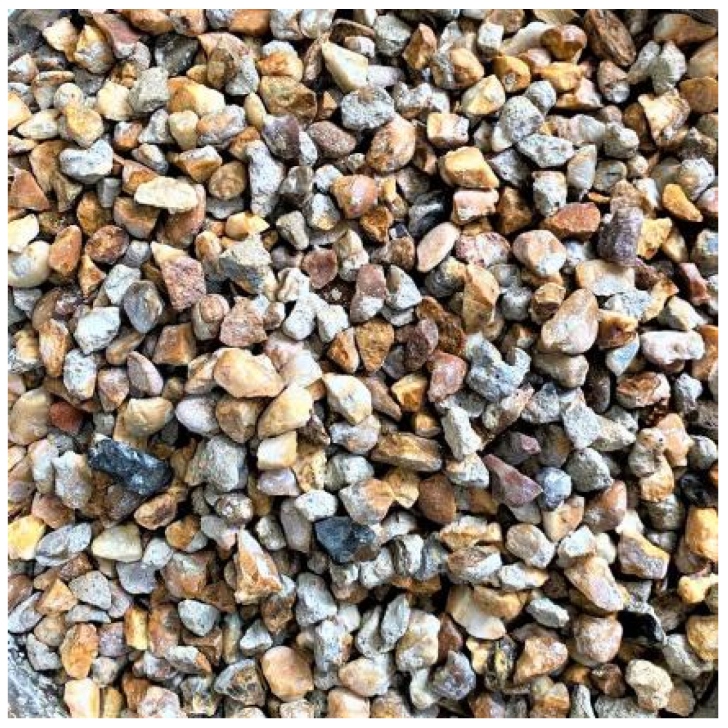















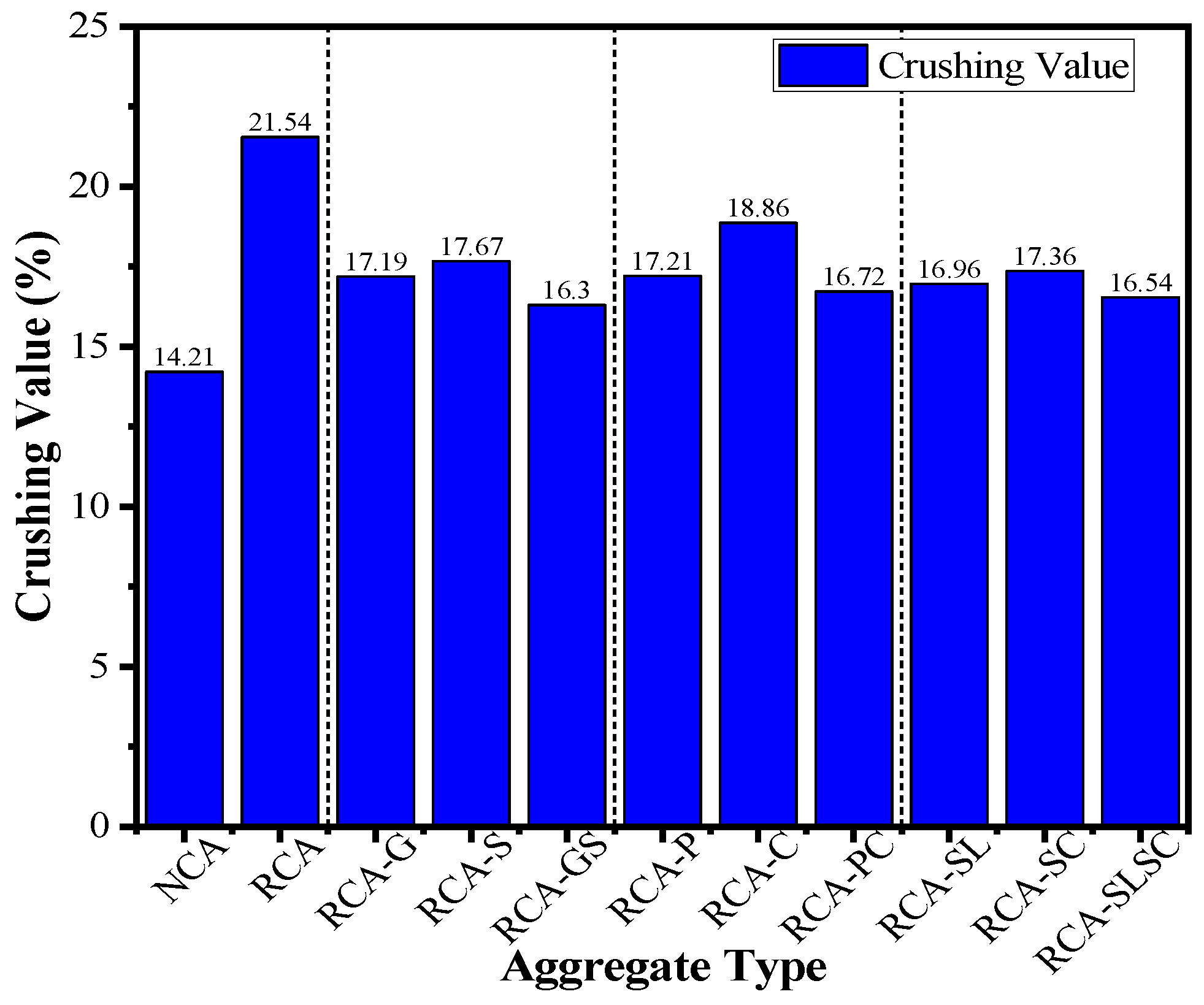
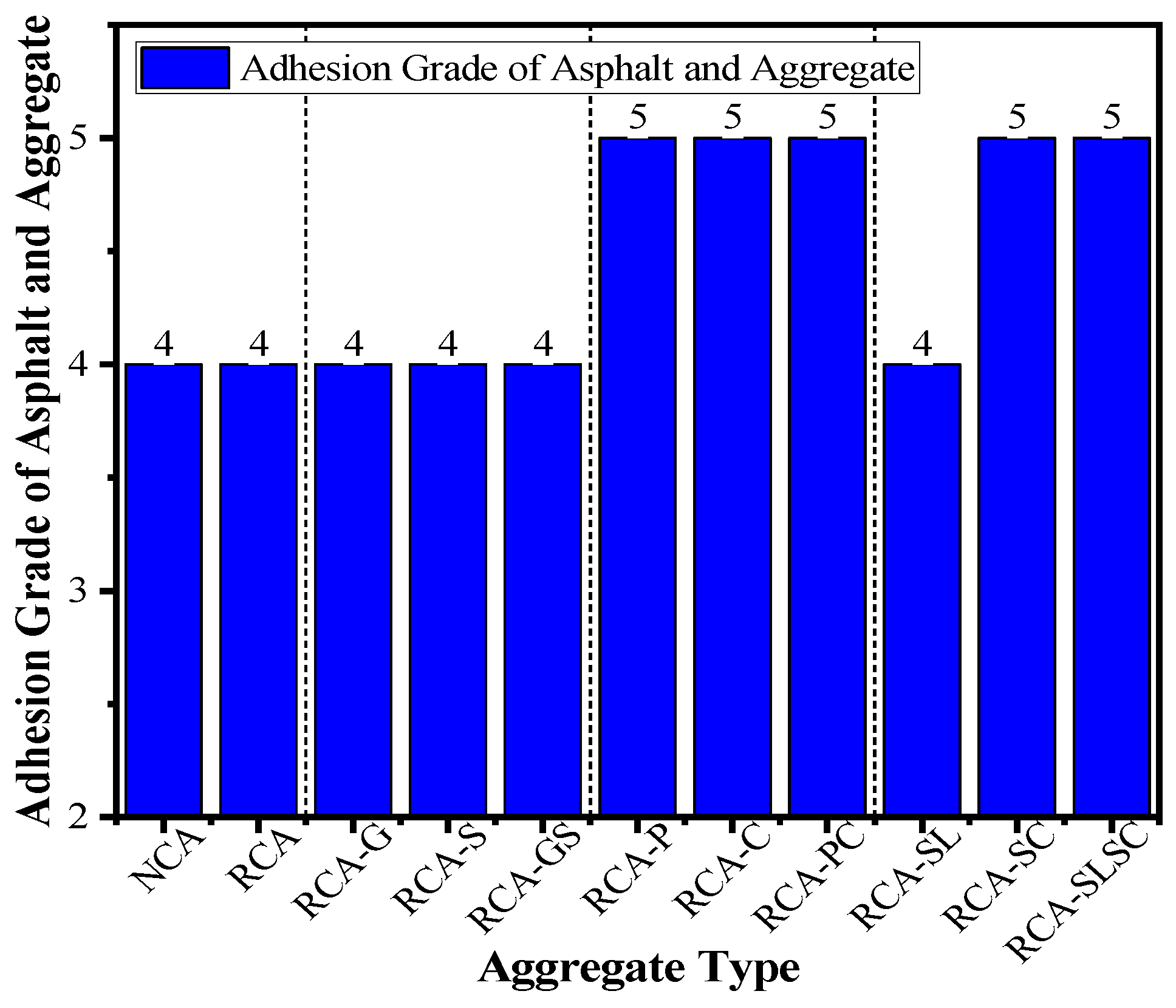



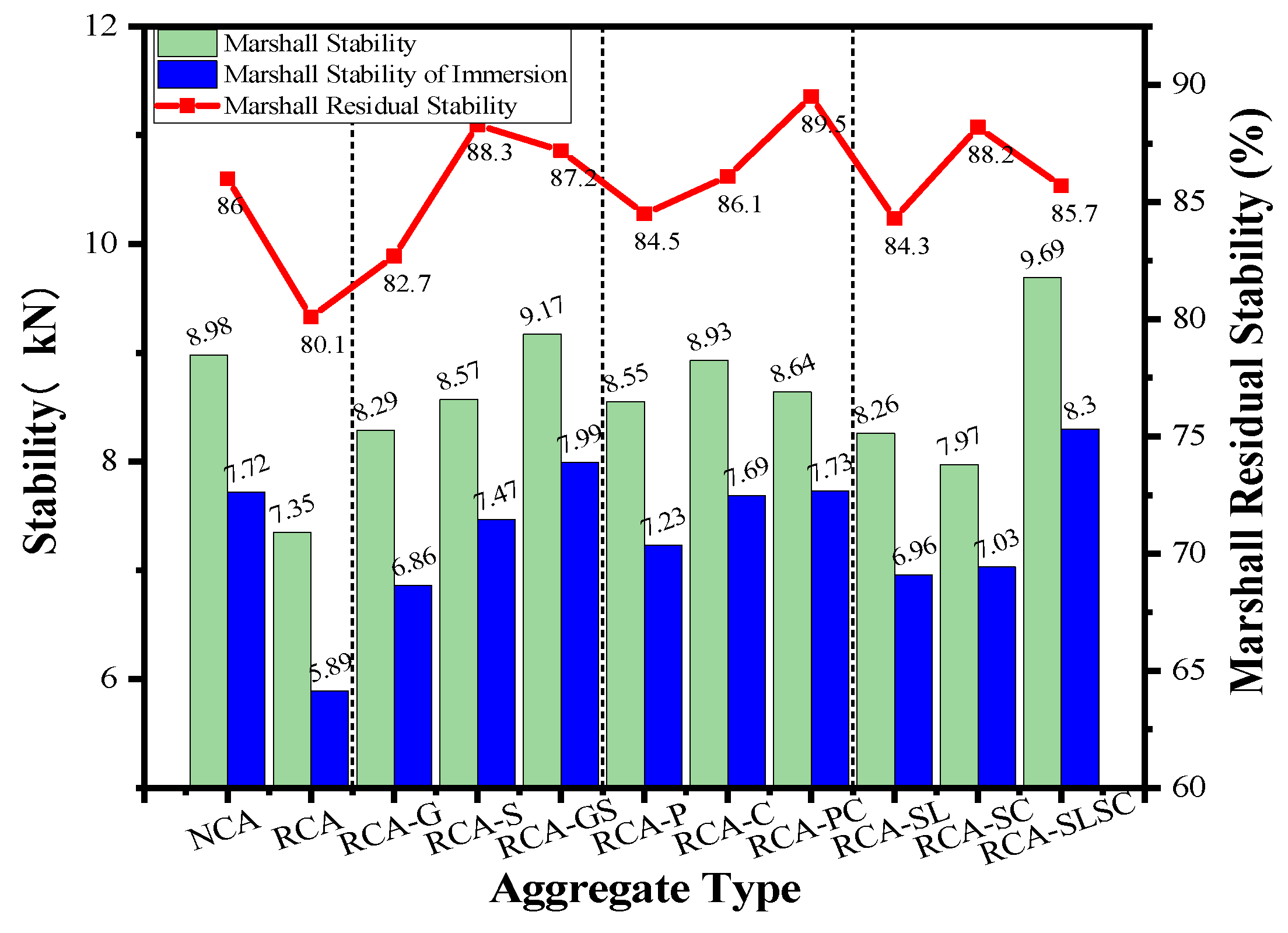



| Properties | Test Values | Requirements | Test Method [27] |
|---|---|---|---|
| Penetration (2 °C, 100 g, 5 s)/0.1 mm | 50.9 | 40~60 | T 0604 |
| Penetration index PI | 0.21 | ≥0 | T 0604 |
| Ductility (5 °C, 5 cm·min−1)/cm | 89 | ≥20 | T 0605 |
| Softening point (°C) | 81.9 | ≥60 | T 0606 |
| Flash point (°C) | 285 | ≥230 | T 0611 |
| Viscosity (135 °C)/Pa.s | 2.4 | ≤3.0 | T 0625 |
| Solubility (%) | 99.8 | ≥99 | T 0607 |
| Properties | Test Values | Requirements | Test Method [28] |
|---|---|---|---|
| Apparent density (g/cm3) | 2.64 | ≥2.5 | T 0352 |
| Water content (%) | 0.36 | ≤1 | - |
| Particle size<0.6 mm (%) | 100 | 100 | T 0351 |
| Particle size<0.7 mm (%) | 92.5 | 90~100 | T 0351 |
| Particle size<0.8 mm (%) | 87.8 | 75~100 | T 0351 |
| Appearance | No Agglomerates Formed | No Agglomerates Formed | - |
| Hydrophilic coefficient (%) | 0.87 | <1 | T 0353 |
| Properties | Test Values | Requirements | Test Method [28] |
|---|---|---|---|
| Apparent density (g/cm3) | 2.73 | ≥2.50 | T 0328 |
| Sand content (%) | 61 | ≥60 | T 0333 |
| Angularity (s) | 49 | ≥30 | T 0344 |
| Paticle size <0.075 mm (%) | 1.04 | ≤3.0 | - |
| Properties | Grain Size (mm) | Test Values | Test Method [28] | |
|---|---|---|---|---|
| NCA | RCA | |||
| Apparent density (g/cm3) | 4.75–9.5 | 2.70 | 2.54 | T 0304 |
| 9.5–13.2 | 2.68 | 2.52 | ||
| Water absorption (%) | 4.75–9.5 | 0.99 | 8.73 | |
| 9.5–13.2 | 0.91 | 7.89 | ||
| Crushing value (%) | 9.5–13.2 | 14.21 | 21.54 | T 0316 |
| Grain Size (mm) | NCA | RCA | RCA-G | RCA-S | RCA-GS | RCA-P | RCA-C | RCA-PC | RCA-SL | RCA-SC | RCA-SLSC | |
|---|---|---|---|---|---|---|---|---|---|---|---|---|
| Apparent density (g/cm3) | 4.75–9.5 | 2.70 | 2.54 | 2.56 | 2.66 | 2.70 | 2.66 | 2.58 | 2.68 | 2.62 | 2.67 | 2.72 |
| 9.5–13.2 | 2.68 | 2.52 | 2.54 | 2.62 | 2.67 | 2.63 | 2.57 | 2.63 | 2.59 | 2.63 | 2.68 | |
| Water absorption (%) | 4.75–9.5 | 0.99 | 8.73 | 6.26 | 5.34 | 5.7 | 6.83 | 11.65 | 11.57 | 6.06 | 5.63 | 5.38 |
| 9.5–13.2 | 0.91 | 7.89 | 4.35 | 4.77 | 3.23 | 4.27 | 8.83 | 8.35 | 4.24 | 3.85 | 3.44 | |
| Crushing value (%) | 9.5–13.2 | 14.21 | 21.54 | 17.19 | 17.67 | 16.30 | 17.21 | 18.86 | 16.72 | 16.96 | 17.36 | 16.54 |
Publisher’s Note: MDPI stays neutral with regard to jurisdictional claims in published maps and institutional affiliations. |
© 2022 by the authors. Licensee MDPI, Basel, Switzerland. This article is an open access article distributed under the terms and conditions of the Creative Commons Attribution (CC BY) license (https://creativecommons.org/licenses/by/4.0/).
Share and Cite
Lei, B.; Xiong, Q.; Tang, Z.; Yao, Z.; Jiang, J. Effect of Recycled Aggregate Modification on the Properties of Permeable Asphalt Concrete. Sustainability 2022, 14, 10495. https://doi.org/10.3390/su141710495
Lei B, Xiong Q, Tang Z, Yao Z, Jiang J. Effect of Recycled Aggregate Modification on the Properties of Permeable Asphalt Concrete. Sustainability. 2022; 14(17):10495. https://doi.org/10.3390/su141710495
Chicago/Turabian StyleLei, Bin, Qianghui Xiong, Zhuo Tang, Zhimin Yao, and Jianguo Jiang. 2022. "Effect of Recycled Aggregate Modification on the Properties of Permeable Asphalt Concrete" Sustainability 14, no. 17: 10495. https://doi.org/10.3390/su141710495
APA StyleLei, B., Xiong, Q., Tang, Z., Yao, Z., & Jiang, J. (2022). Effect of Recycled Aggregate Modification on the Properties of Permeable Asphalt Concrete. Sustainability, 14(17), 10495. https://doi.org/10.3390/su141710495








